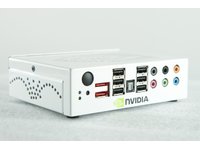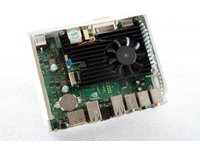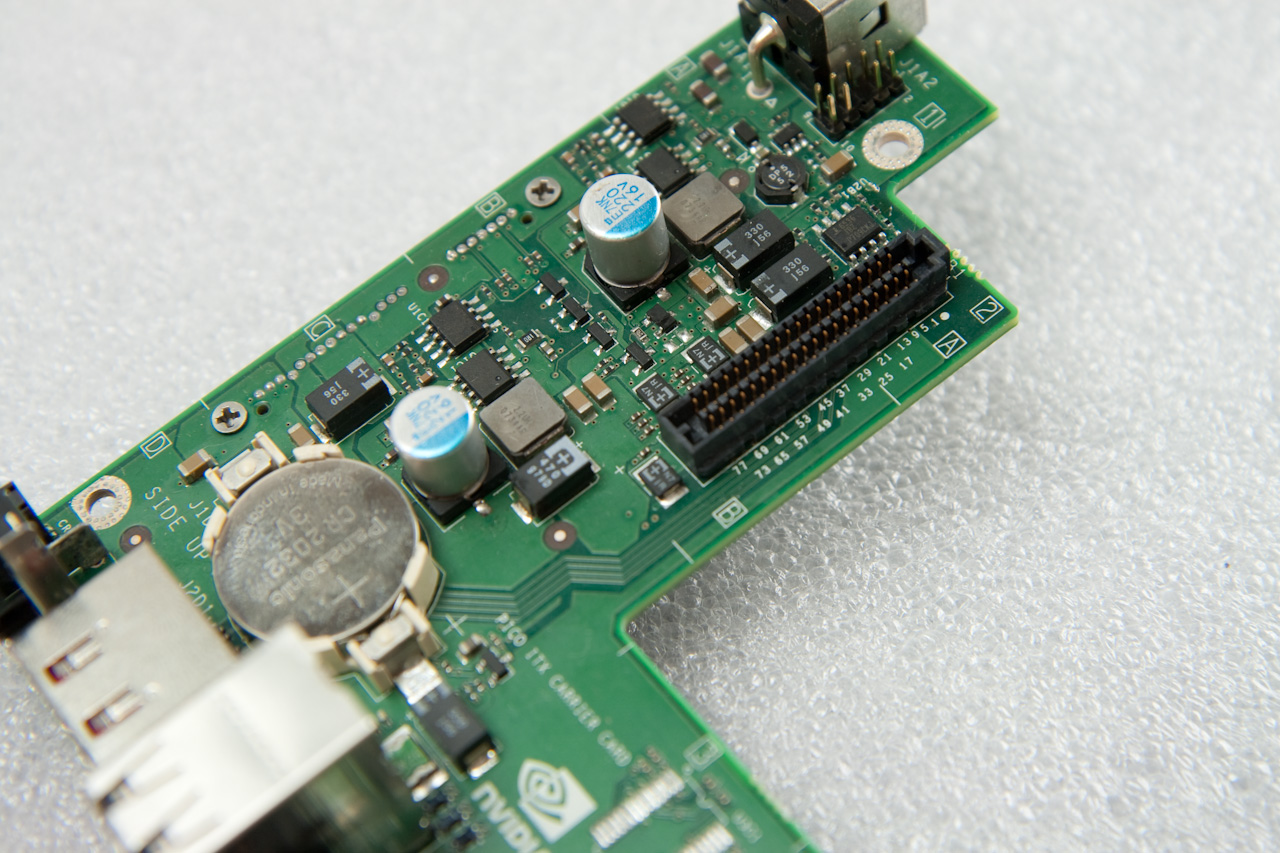Nvidia's Ion: Lending Atom Some Wings
Hardware Under The Hood
We removed the Ion platform from its box with a certain amount of excitement; it’s an object that inspires fascination. Being accustomed to the Mac mini, we were genuinely surprised by its compactness—we couldn’t believe such a complete platform could fit in there.


Of course, we got out our screwdriver and took a look inside. First came the cover panel that protects the hard disk--a 200 GB Seagate Momentus 7200.2. The main entrance, though, is via the other side of the micro-case. You slide back the top cover, and then the motherboard becomes visible.


The Ion is, in fact, made up of two PCBs stacked on top of each other inside the chassis. The first is the motherboard itself. The Atom processor is mounted on it, next to the chipset. They’re both covered by a thin aluminum radiator with a 40 mm x 10 mm fan in its center. Judging from its size, we can already surmise that the cooling system will provide minimal heat dissipation.
In addition to the processor and chipset, mounted on the motherboard are the necessary connectors for making this a standalone PC: Serial ATA (SATA), Gigabit Ethernet, Dual-Link DVI and USB 2.0 ports, and even an HDMI port.
What about the RAM? It goes into the back of the motherboard, in a SO-DIMM slot. To suit the occasion, Nvidia has used DDR3 memory. While still more expensive than DDR2, DDR3 is a good choice here. Its higher frequency guarantees increased bandwidth to the CPU, and more importantly to the chipset and its integrated graphics core, the main memory is used as the video frame buffer. It’s also more power-friendly, which is right on target for a platform touted for its low power consumption.
One final connector on the motherboard, which we couldn't immediately identify, serves to connect the motherboard with its daughterboard on the level below. Despite its proprietary physical format, this port is surely a PCI Express. It has to supply enough bandwidth for all possible connections to the daughterboard—and there’s a number of them: SATA (used by the internal hard disk), two eSATA, six USB, eight-channel analog audio, and digital optical. This port also supplies power to the motherboard, so the latter isn’t entirely autonomous.
In all, our Ion reference PC has no less than:
Get Tom's Hardware's best news and in-depth reviews, straight to your inbox.
- 2 internal SATA ports
- 2 eSATA ports
- 7 USB 2.0 ports
- 6 analog audio jacks
- 1 S/PDIF audio connector
- 1 DVI Dual Link connector
- 1 VGA connector
- 1 HDMI connector
- 1 Gigabit Ethernet connector
It’s a pleasure to see such complete connectivity on such a small PC. Let’s hope that the nettops based on the Ion platform will keep this decisive advantage of the reference design.
-
rootheday Let's be clear - the Ion reference platform is for a nettop - not a netbook. Its based on the dual core Atom 330. I doubt very much that Ion with a single code Atom 230 or N270 would have enough horsepower to do the BD decryption required for BD playback.Reply -
matthieu lamelot Please, let me be clear : the platform reviewed was equipped with an Atom 230, not a 330, as is perfectly obvious from the pictures (one single die on the CPU package).Reply
And, yes, it's powerful enough (thanks to the 9400M) to smoothly playback a BD like Casino Royale (including the HDCP decryption). CPU utilization rose to around 67 % during that test.
And even though the Ion ref platform is kind of a nettop (and we tested it with that in mind, comparing it to Intel's nettop platform), it could also fit in a netbook since 9400M TDP is very close to that of Intel 945GSE chipset that is found in most netbooks today : 12 W compared to 9,3 W. Nvidia and its partners would just need to drop 9400M's frequency a bit. -
randomizer Matthieu, I'm not sure who makes the onboard sound, but if it's Realtek you need to have Stereo Mix enabled for CoD 4 to run. Also, I found that I couldn't start CoD4 (with what appears to be the same error even though I can't really understand it) without plugging in speakers. Yes, speakers. Although any output device might have sufficed.Reply -
mitch074 Realtek codecs are quite common (thus I concur with randomizer); some are quite advanced in that they do automatic detection of what kind of hardware is connected to what pin (through best guess from device impedance, considering the low dB noise those codecs output they are some precise piece of ingineering), allowing autodetection of the sound setup (they will detect if you replace a microphone with a set of speakers, and switch configuration from stereo+microphone to 4.0 audio, for example; that requires driver support though).Reply
If CoD4 requires sound (some games are funny this way) and no hardware is plugged in, then the sound card may report a status CoD4 wasn't expecting, and refuse to run. -
randomizer Well you'd think that they would have patched the game so that it doesn't have problems with needing Stereo Mix and output devices by now. What if my speakers are dead? That's just poor...Reply -
amnotanoobie I immediately looked at the benchmark images, instead of reading the accompanying text around it, and I thought "WTH is AMD (green bar) doing on the nVidia ION platform." I thought I was linked to another page of another review.Reply -
hei man pls ...for now nvidia platform has some advantages but with DX11 you will not need gpu any more ...so for now it's ok for future this platform will be nothing but dustReply
-
nukemaster You may not need a GPU, but a GPU is still far faster then the cpu at running games.Reply
Good review its about time Atom got a little help. -
liemfukliang I wont buy atom until it can run PCMark Vantage, 3DMark Vantage. I don't mean it has to be high score, I just one it is finish the test and not error. :)Reply -
Tekkamanraiden I'd like to be able to buy one of those little reference systems. It would make a nice little HTPC.Reply

